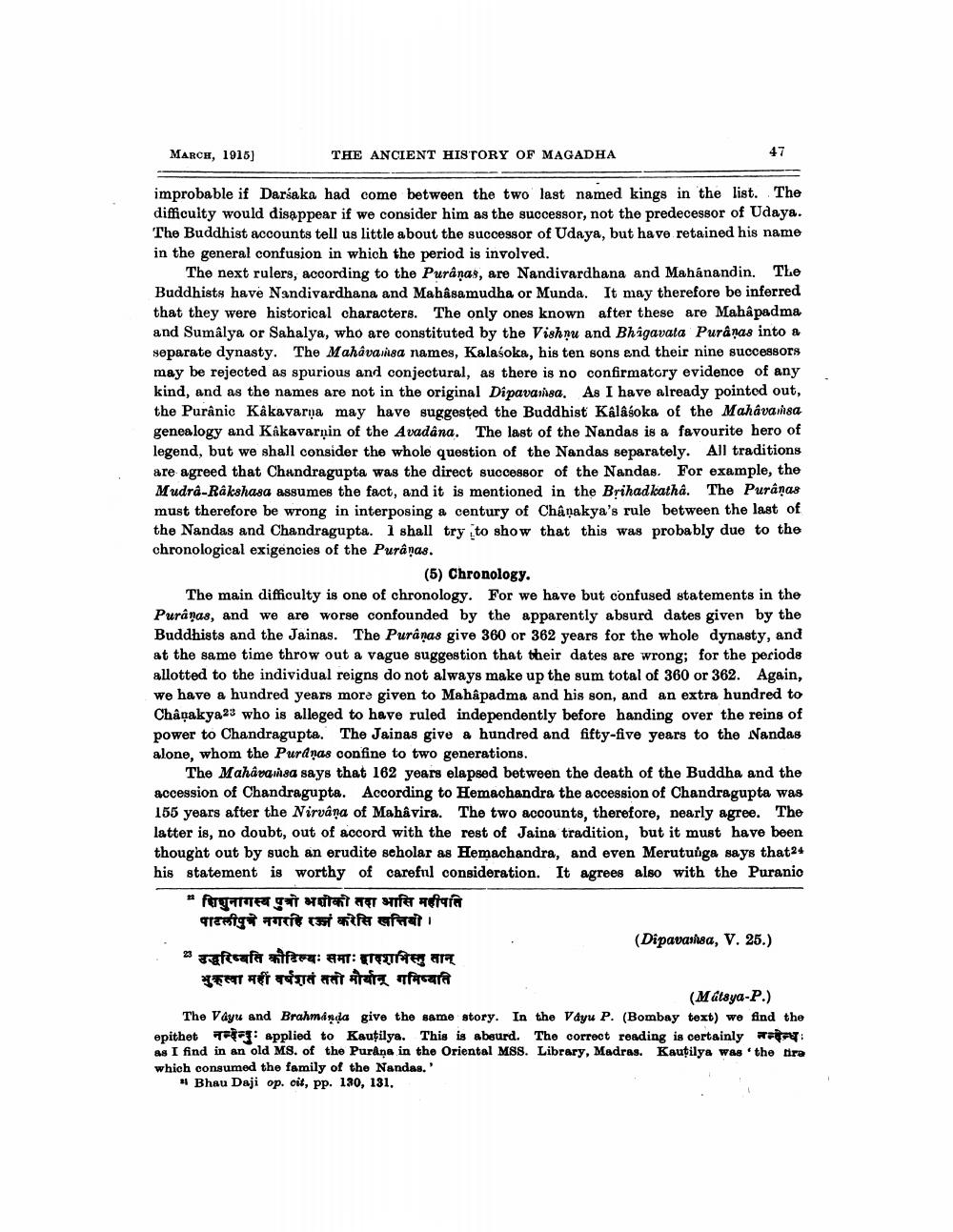________________
MARCH, 1915)
THE ANCIENT HISTORY OF MAGADHA
improbable if Darsaka had come between the two last named kings in the list. The difficulty would disappear if we consider him as the successor, not the predecessor of Udaya. The Buddhist accounts tell us little about the successor of Udaya, but have retained his name in the general confusion in which the period is involved.
The next rulers, according to the Puranas, are Nandivardhana and Mahanandin. The Buddhists have Nandivardhana and Mahâsamudha or Munda. It may therefore be inferred that they were historical characters. The only ones known after these are Mahapadma and Sumâlya or Sahalya, who are constituted by the Vishnu and Bhagavata Purâņas into a separate dynasty. The Mahava isa names, Kalaśoka, his ten sons and their nine successors may be rejected as spurious and conjectural, as there is no confirmatory evidence of any kind, and as the names are not in the original Dipavarisa. As I have already pointed out, the Puranic Kakavarņa may have suggested the Buddhist Kálásoka of the Mahavainsa genealogy and Kakavarnin of the Avadana. The last of the Nandas is a favourite hero of legend, but we shall consider the whole question of the Nandas separately. All traditions are agreed that Chandragupta was the direct successor of the Nandas. For example, the Mudra-Rakshasa assumes the fact, and it is mentioned in the Brihad katha. The Puranas must therefore be wrong in interposing a century of Châņakya's rule between the last of the Nandas and Chandragupta. I shall try to show that this was probably due to the chronological exigencies of the Purâņas.
(5) Chronology. The main difficulty is one of chronology. For we have but confused statements in the Puranas, and we are worse confounded by the apparently absurd dates given by the Buddhists and the Jainas. The Puranas give 360 or 362 years for the whole dynasty, and at the same time throw out a vague suggestion that their dates are wrong; for the periods allotted to the individual reigns do not always make up the sum total of 360 or 362. Again, we have a hundred years more given to Mahapadma and his son, and an extra hundred to Chanakya23 who is alleged to have ruled independently before handing over the reins of power to Chandragupta. The Jainas give a hundred and fifty-five years to the Nandas alone, whom the Puranas confine to two generations.
The Maharansa says that 162 years elapsed between the death of the Buddha and the accession of Chandragupta. According to Hemachandra the accession of Chandragupta was 155 years after the Nirvana of Mahavira. The two accounts, therefore, nearly agree. The latter is, no doubt, out of accord with the rest of Jaina tradition, but it must have been thought out by such an erudite scholar as Hemachandra, and even Merutunga says that24 his statement is worthy of carefnl consideration. It agrees also with the Puranio
*शिशुनागस्य पुत्रो भशोको तदा आसि महीपति पाटलीपुत्र नगरहिरनं करेसि खत्तियो ।
(Dipavarisa, V. 25.) . उद्धरिष्यति कौटिल्यः समाः हादशभिस्तु वान् भुक्त्वा महीं वर्षशतं ततो मौर्यानू गमिष्यति
(Matsya-P.) The Vayu and Brahmanda give the same story. In the Vayu P. (Bombay text) we find the epithet : applied to Kautilya. This is absurd. The correct reading is certainly as I find in an old MS. of the Purkņa in the Oriental MSS. Library, Madras. Kautilya was the fire which consumed the family of the Nandas.'
# Bhau Daji op. cit, pp. 130, 131.




